A Greening Strategy of Mitigation of the Thermal Environment for Coastal Sloping Urban Space
Abstract
:1. Introduction
2. Materials and Methods
2.1. Study Area
2.2. ENVI-Met Model
2.3. Field Measurements and Model Validation
2.4. Construction of the Simulation Models
2.5. Statistical Analysis
3. Results and Discussion
3.1. Measured and Simulated Thermal Environment
3.2. Temperature Simulations in Six Scenarios
3.3. PET Analysis Based on the Simulation Scenarios
3.3.1. Horizontal Distribution of PET
3.3.2. Vertical Distribution of PET
3.3.3. Daytime Distribution of PET
3.3.4. PET of the Coastal Tourist Area
3.4. Discussion
4. Conclusions
Supplementary Materials
Author Contributions
Funding
Institutional Review Board Statement
Informed Consent Statement
Data Availability Statement
Conflicts of Interest
References
- Williams, S.; Nitschke, M.; Weinstein, P.; Pisaniello, D.L.; Parton, K.A.; Bi, P. The impact of summer temperatures and heatwaves on mortality and morbidity in Perth, Australia 1994–2008. Environ. Int. 2012, 40, 33–38. [Google Scholar] [CrossRef] [PubMed]
- Zhang, Y.; Nitschke, M.; Bi, P. Risk factors for direct heat-related hospitalization during the 2009 Adelaide heatwave: A case crossover study. Sci. Total. Environ. 2013, 442, 1–5. [Google Scholar] [CrossRef] [PubMed]
- Jamei, E.; Rajagopalan, P.; Seyedmahmoudian, M.; Jamei, Y. Review on the impact of urban geometry and pedestrian level greening on outdoor thermal comfort. Renew. Sustain. Energy Rev. 2016, 54, 1002–1017. [Google Scholar] [CrossRef]
- Santamouris, M.; Synnefa, A.; Karlessi, T. Using advanced cool materials in the urban built environment to mitigate heat islands and improve thermal comfort conditions. Sol. Energy 2011, 85, 3085–3102. [Google Scholar] [CrossRef]
- Lai, D.; Liu, W.; Gan, T.; Liu, K.; Chen, Q. A review of mitigating strategies to improve the thermal environment and thermal comfort in urban outdoor spaces. Sci. Total. Environ. 2019, 661, 337–353. [Google Scholar] [CrossRef]
- Tablada, A.; De Troyer, F.; Blocken, B.; Carmeliet, J.; Verschure, H. On natural ventilation and thermal comfort in compact urban environments—The Old Havana case. Build. Environ. 2009, 44, 1943–1958. [Google Scholar] [CrossRef]
- Ziter, C.D.; Pedersen, E.J.; Kucharik, C.J.; Turner, M.D. Scale-dependent interactions between tree canopy cover and impervious surfaces reduce daytime urban heat during summer. Proc. Natl. Acad. Sci. USA 2019, 116, 7575–7580. [Google Scholar] [CrossRef] [Green Version]
- Bettio, L.; Nairn, J.R.; McGibbony, S.C.; Hope, P.; Tupper, A.; Fawcett, R.J.B. A heatwave forecast service for Australia. Proc. R. Soc. Vic. 2019, 131, 53–59. [Google Scholar] [CrossRef] [Green Version]
- Zhou, X.; Okaze, T.; Ren, C.; Cai, M.; Ishida, Y.; Watanabe, H.; Mochida, A. Evaluation of urban heat islands using local climate zones and the influence of sea-land breeze. Sustain. Cities Soc. 2020, 55, 102060. [Google Scholar] [CrossRef]
- Saburo, M.; Sekine, T.; Narita, K.; Nishina, D. Study of the effects of a river on the thermal environment in an urban area. Energy Build. 1991, 16, 993–1001. [Google Scholar]
- Oke, T.R. City size and the urban heat island. Atmos. Environ. 1973, 7, 769–779. [Google Scholar] [CrossRef]
- Theeuwes, N.E.; Solcerová, A.; Steeneveld, G.J. Modeling the influence of open water surfaces on the summertime temperature and thermal comfort in the city. J. Geophys. Res. Atmos. 2013, 118, 8881–8896. [Google Scholar] [CrossRef] [Green Version]
- Völker, S.; Kistemann, T. Developing the urban blue: Comparative health responses to blue and green urban open spaces in Germany. Health Place 2015, 35, 196–205. [Google Scholar] [CrossRef] [PubMed]
- Montazeri, H.; Toparlar, Y.; Blocken, B.; Hensen, J. Simulating the cooling effects of water spray systems in urban landscapes: A computational fluid dynamics study in Rotterdam, The Netherlands. Landsc. Urban Plan. 2017, 159, 85–100. [Google Scholar] [CrossRef]
- Du, H.; Song, X.; Jiang, H.; Kan, Z.; Wang, Z.; Cai, Y. Research on the cooling island effects of water body: A case study of Shanghai, China. Ecol. Indic. 2016, 67, 31–38. [Google Scholar] [CrossRef]
- Yang, G.; Yu, Z.; Jørgensen, G.; Vejre, H. How can urban blue-green space be planned for climate adaption in high-latitude cities? A seasonal perspective. Sustain. Cities Soc. 2020, 53, 101932. [Google Scholar] [CrossRef]
- Sun, R.; Chen, L. How can urban water bodies be designed for climate adaptation? Landsc. Urban Plan. 2012, 105, 27–33. [Google Scholar] [CrossRef]
- Žuvela-Aloise, M.; Koch, R.; Buchholz, S.; Früh, B. Modelling the potential of green and blue infrastructure to reduce urban heat load in the city of Vienna. Clim. Chang. 2016, 135, 425–438. [Google Scholar] [CrossRef] [Green Version]
- Ren, Y.; Deng, L.-Y.; Zuo, S.-D.; Song, X.-D.; Liao, Y.-L.; Xu, C.-D.; Chen, Q.; Hua, L.-Z.; Li, Z.-W. Quantifying the influences of various ecological factors on land surface temperature of urban forests. Environ. Pollut. 2016, 216, 519–529. [Google Scholar] [CrossRef] [Green Version]
- Taleghani, M. Outdoor thermal comfort by different heat mitigation strategies—A review. Renew. Sustain. Energy Rev. 2018, 81, 2011–2018. [Google Scholar] [CrossRef]
- Taha, H. Cool Cities: Counteracting Potential Climate Change and its Health Impacts. Curr. Clim. Chang. Rep. 2015, 1, 163–175. [Google Scholar] [CrossRef]
- Monteiro, M.V.; Doick, K.J.; Handley, P.; Peace, A. The impact of greenspace size on the extent of local nocturnal air temperature cooling in London. Urban For. Urban Green. 2016, 16, 160–169. [Google Scholar] [CrossRef]
- Hardin, P.J.; Jensen, R.R. The effect of urban leaf area on summertime urban surface kinetic temperatures: A Terre Haute case study. Urban For. Urban Green. 2007, 6, 63–72. [Google Scholar] [CrossRef]
- Qiu, G.Y.; Zou, Z.; Li, X.; Li, H.; Guo, Q.; Yan, C.; Tan, S. Experimental studies on the effects of green space and evapotranspiration on urban heat island in a subtropical megacity in China. Habitat Int. 2017, 68, 30–42. [Google Scholar] [CrossRef]
- Ren, C.; Yang, R.; Cheng, C.; Xing, P.; Fang, X.; Zhang, S.; Wang, H.; Shi, Y.; Zhang, X.; Kwok, Y.T.; et al. Creating breathing cities by adopting urban ventilation assessment and wind corridor plan—The implementation in Chinese cities. J. Wind. Eng. Ind. Aerodyn. 2018, 182, 170–188. [Google Scholar] [CrossRef]
- Zhang, Y.; Hu, X.; Cao, X.; Liu, Z. Numerical Simulation of the Thermal Environment during Summer in Coastal Open Space and Research on Evaluating the Cooling Effect: A Case Study of May Fourth Square, Qingdao. Sustainability 2022, 14, 15126. [Google Scholar] [CrossRef]
- Xiao, J.; Yuizono, T. Climate-adaptive landscape design: Microclimate and thermal comfort regulation of station square in the Hokuriku Region, Japan. Build. Environ. 2022, 212, 108813. [Google Scholar] [CrossRef]
- Yang, Y.; Gatto, E.; Gao, Z.; Buccolieri, R.; Morakinyo, T.E.; Lan, H. The “plant evaluation model” for the assessment of the impact of vegetation on outdoor microclimate in the urban environment. Build. Environ. 2019, 159, 106151. [Google Scholar] [CrossRef]
- Morakinyo, T.E.; Kong, L.; Lau, K.K.-L.; Yuan, C.; Ng, E. A study on the impact of shadow-cast and tree species on in-canyon and neighborhood’s thermal comfort. Build. Environ. 2017, 115, 1–17. [Google Scholar] [CrossRef]
- Koc, C.B.; Osmond, P.; Peters, A. Evaluating the cooling effects of green infrastructure: A systematic review of methods, indicators and data sources. Sol. Energy 2018, 166, 486–508. [Google Scholar] [CrossRef]
- Tian, Y.; Ma, Y.; Dong, H.; Guo, L. Analysis of climatic and environmental characteristics in Qingdao under the background of climate change. Trans. Oceanol. Limnol. 2012, 04, 10–15. [Google Scholar]
- Liu, Z.; Cheng, W.; Jim, C.; Morakinyo, T.E.; Shi, Y.; Ng, E. Heat mitigation benefits of urban green and blue infrastructures: A systematic review of modeling techniques, validation and scenario simulation in ENVI-met V4. Build. Environ. 2021, 200, 107939. [Google Scholar] [CrossRef]
- Liu, Z.; Zheng, S.; Zhao, L. Evaluation of the ENVI-Met Vegetation Model of Four Common Tree Species in a Subtropical Hot-Humid Area. Atmosphere 2018, 9, 198. [Google Scholar] [CrossRef] [Green Version]
- Acero, J.A.; Herranz-Pascual, K. A comparison of thermal comfort conditions in four urban spaces by means of measurements and modelling techniques. Build. Environ. 2015, 93, 245–257. [Google Scholar] [CrossRef]
- Chicco, D.; Warrens, M.J.; Jurman, G. The coefficient of determination R-squared is more informative than SMAPE, MAE, MAPE, MSE and RMSE in regression analysis evaluation. PeerJ Comput. Sci. 2021, 7, e623. [Google Scholar] [CrossRef] [PubMed]
- Fox, D.G. Judging Air Quality Model Performance. Bull. Am. Meteorol. Soc. 1981, 62, 599–609. [Google Scholar] [CrossRef]
- Willmott, C.J. Some Comments on the Evaluation of Model Performance. Bull. Am. Meteorol. Soc. 1982, 63, 1309–1313. [Google Scholar] [CrossRef]
- Stunder, M.; Sethuraman, S. A statistical evaluation and comparison of coastal point source Dispersion Models. Atmos. Environ. 1986, 20, 301–315. [Google Scholar] [CrossRef]
- Forouzandeh, A. Numerical modeling validation for the microclimate thermal condition of semi-closed courtyard spaces between buildings. Sustain. Cities Soc. 2018, 36, 327–345. [Google Scholar] [CrossRef]
- Tong, S.; Wong, N.H.; Jusuf, S.K.; Tan, C.L.; Wong, H.F.; Ignatius, M.; Tan, E. Study on correlation between air temperature and urban morphology parameters in built environment in northern China. Build. Environ. 2018, 127, 239–249. [Google Scholar] [CrossRef]
- Xu, D.; Zhou, D.; Wang, Y.; Xu, W.; Yang, Y. Field measurement study on the impacts of urban spatial indicators on urban climate in a Chinese basin and static-wind city. Build. Environ. 2019, 147, 482–494. [Google Scholar] [CrossRef]
- Perini, K.; Magliocco, A. Effects of vegetation, urban density, building height, and atmospheric conditions on local temperatures and thermal comfort. Urban For. Urban Green. 2014, 13, 495–506. [Google Scholar] [CrossRef]
- Lai, D.; Lian, Z.; Liu, W.; Guo, C.; Liu, W.; Liu, K.; Chen, Q. A comprehensive review of thermal comfort studies in urban open spaces. Sci. Total. Environ. 2020, 742, 140092. [Google Scholar] [CrossRef] [PubMed]
- Höppe, P.R. Heat balance modelling. Experientia 1993, 49, 741–746. [Google Scholar] [CrossRef] [PubMed]
- Fang, Z.; Feng, X.; Liu, J.; Lin, Z.; Mak, C.M.; Niu, J.; Tse, K.-T.; Xu, X. Investigation into the differences among several outdoor thermal comfort indices against field survey in subtropics. Sustain. Cities Soc. 2018, 44, 676–690. [Google Scholar] [CrossRef]
- Oke, T.R. Boundary Layer Climates; Routledge: London, UK; New York, NY, USA, 2002. [Google Scholar]
- Zhong, S.; Takle, E.S. An Observational Study of Sea- and Land-Breeze Circulation in an Area of Complex Coastal Heating. J. Appl. Meteorol. 1992, 31, 1426–1438. [Google Scholar] [CrossRef]
- Wu, Y.; Hai, G.; Hao, S. Impacts of urban cooling effect based on landscape scale: A review. Natl. Cent. Biotechnol. Inf. 2015, 26, 636–642. [Google Scholar]
- Sihong, D.; Zhang, X.; Jin, X.; Zhou, X.; Shi, X. A review of multi-scale modelling, assessment, and improvement methods of the urban thermal and wind environment. Build. Environ. 2022, 213, 108860. [Google Scholar]
- Bowler, D.E.; Buyung-Ali, L.; Knight, T.M.; Pullin, A.S. Urban greening to cool towns and cities: A systematic review of the empirical evidence. Landsc. Urban Plan. 2010, 97, 147–155. [Google Scholar] [CrossRef]
- Wong, N.H.; Yu, C. Study of green areas and urban heat island in a tropical city. Habitat Int. 2005, 29, 547–558. [Google Scholar] [CrossRef]
- Lin, W.; Yu, T.; Chang, X.; Wu, W.; Zhang, Y. Calculating cooling extents of green parks using remote sensing: Method and test. Landsc. Urban Plan. 2015, 134, 66–75. [Google Scholar] [CrossRef]
- Kaaviya, P.U.; Ramalingam, S. A review of the impact of the green landscape interventions on the urban microclimate of tropical areas. Build. Environ. 2021, 205, 108190. [Google Scholar]

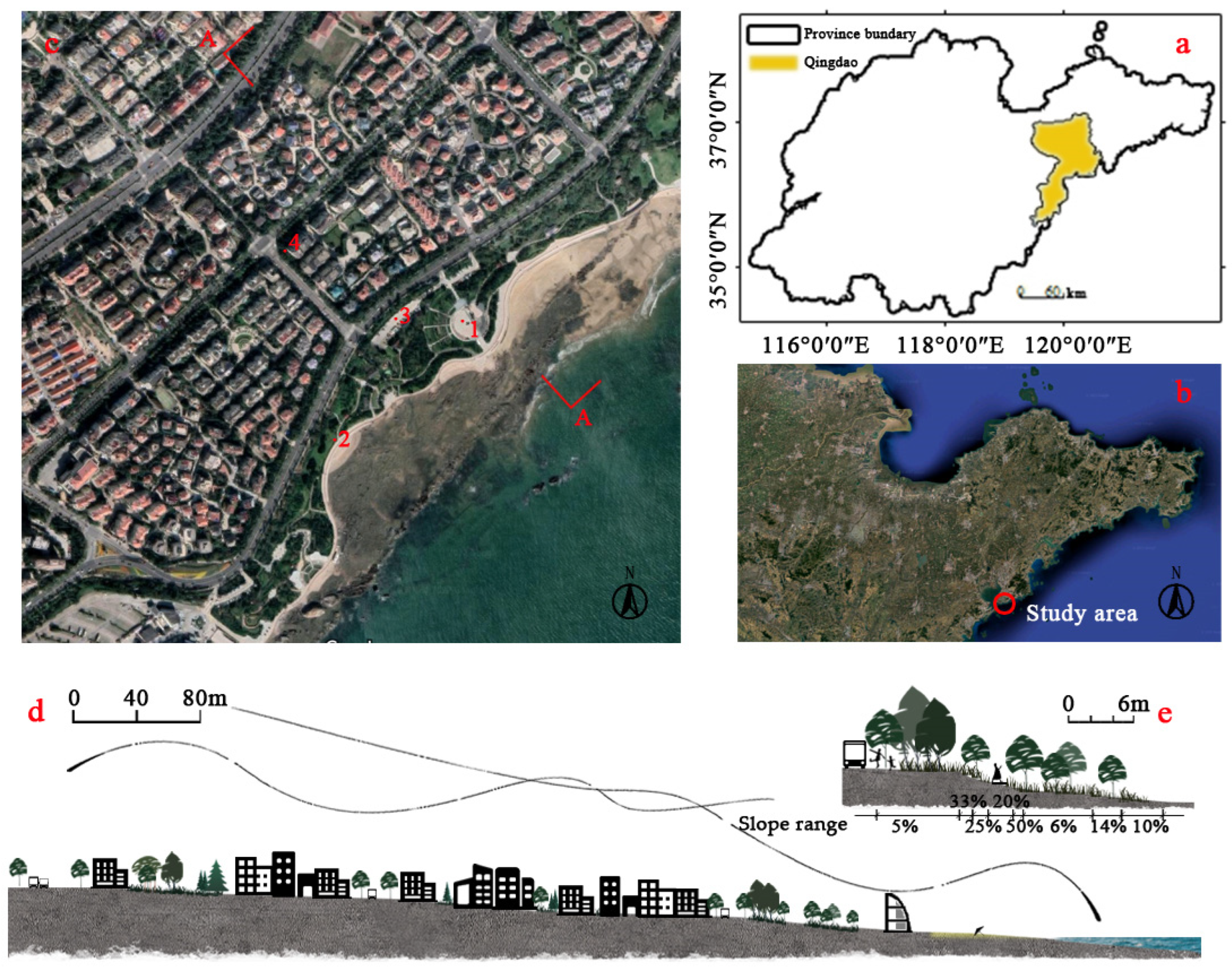
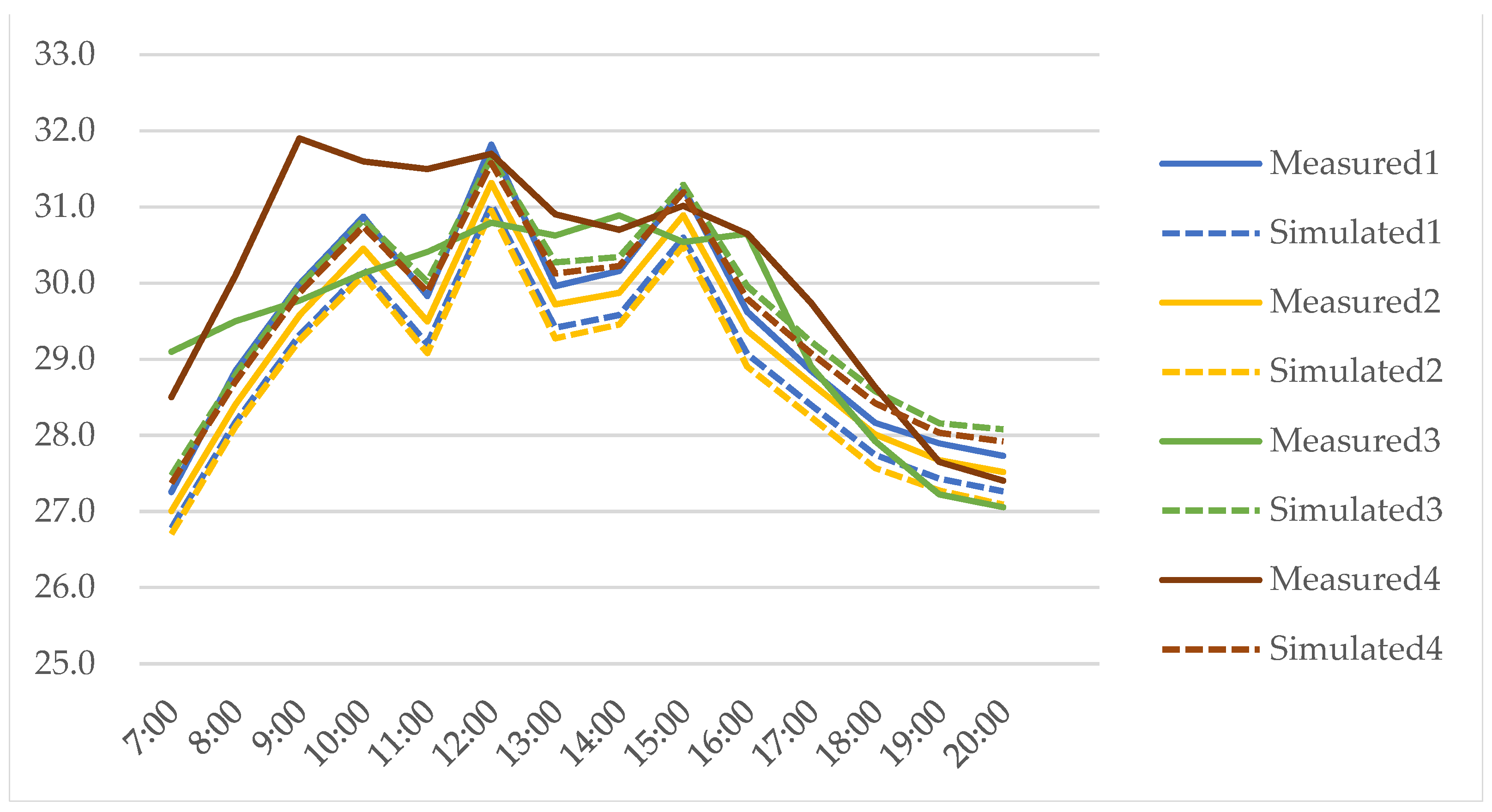
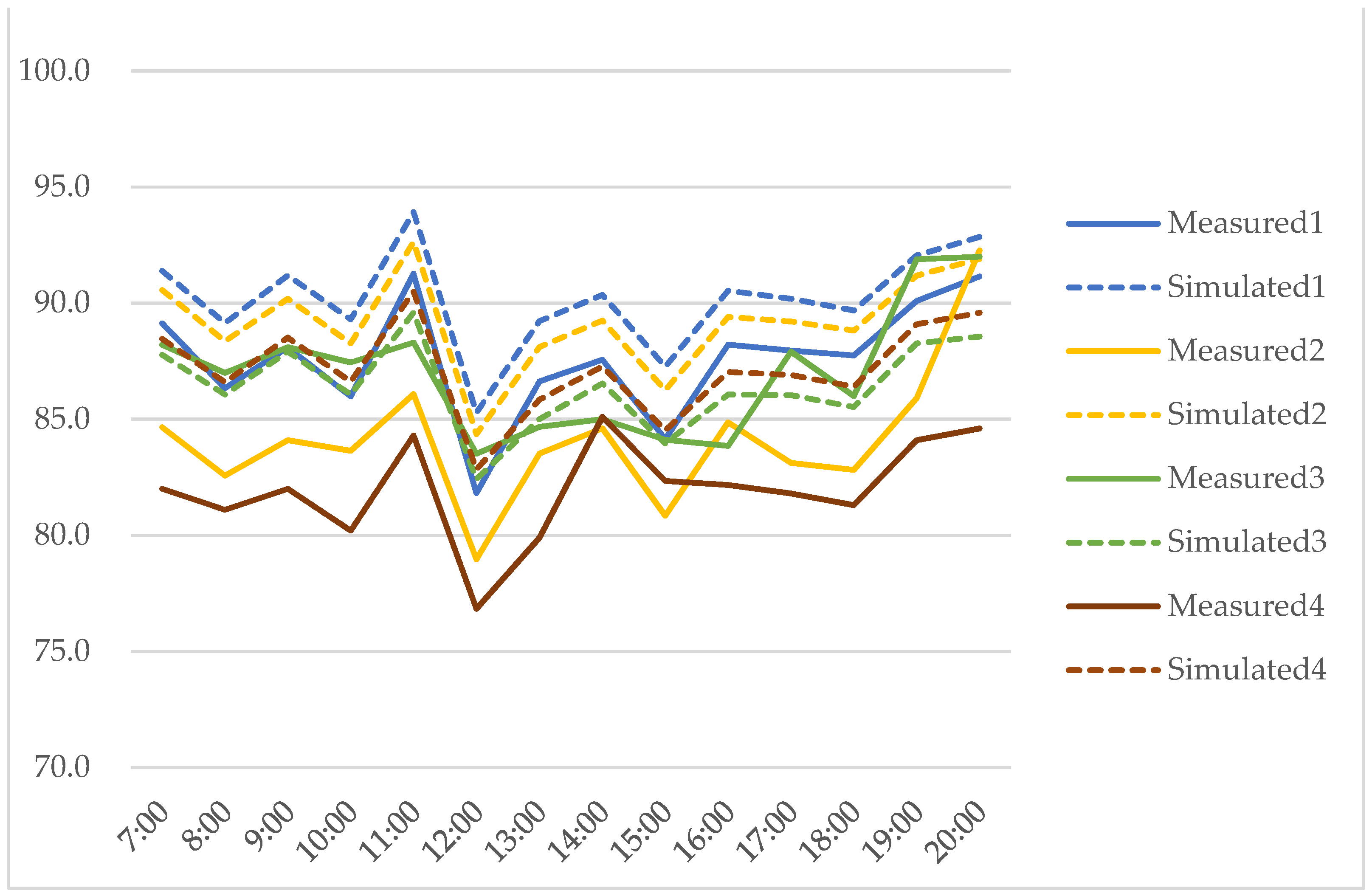



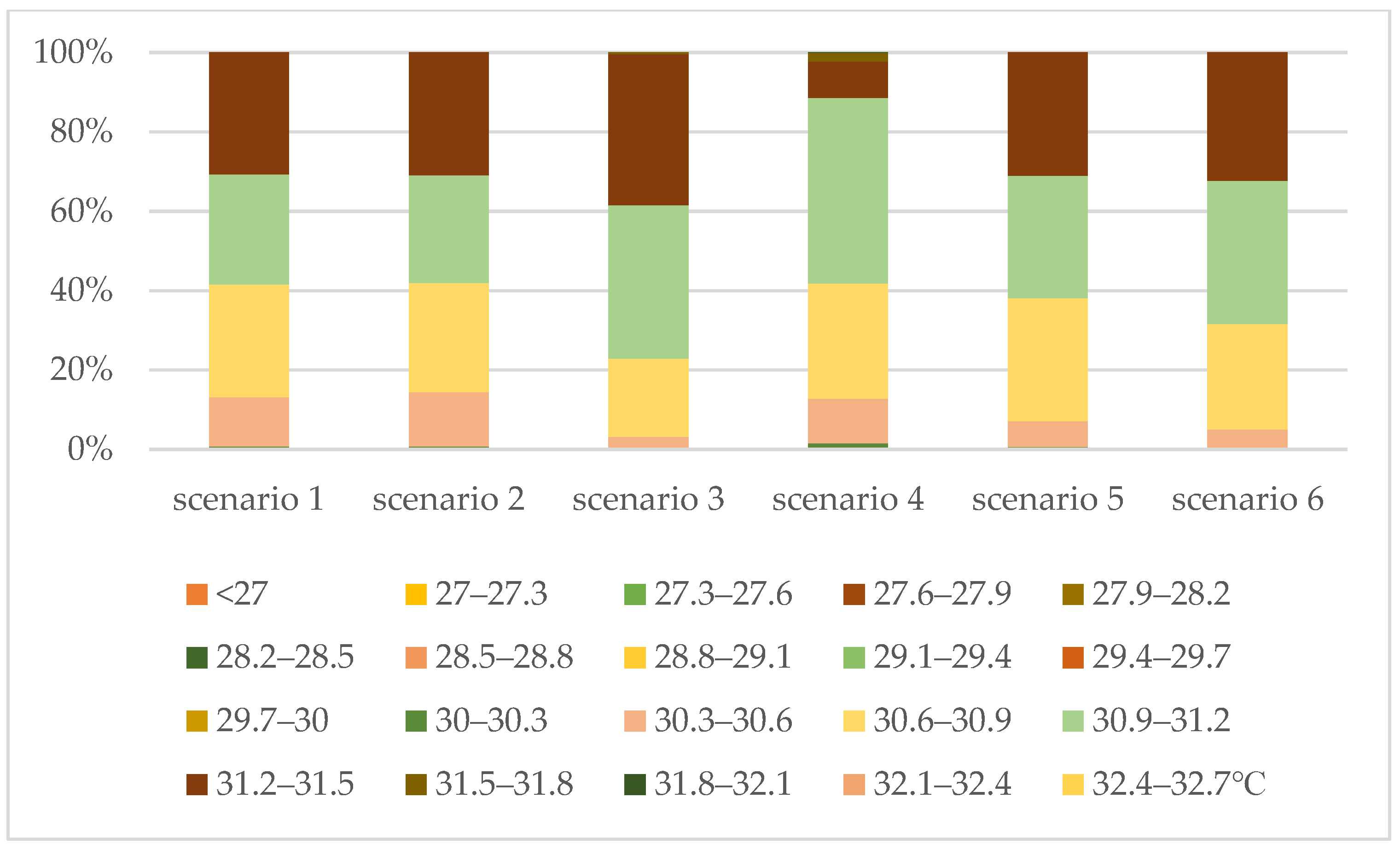
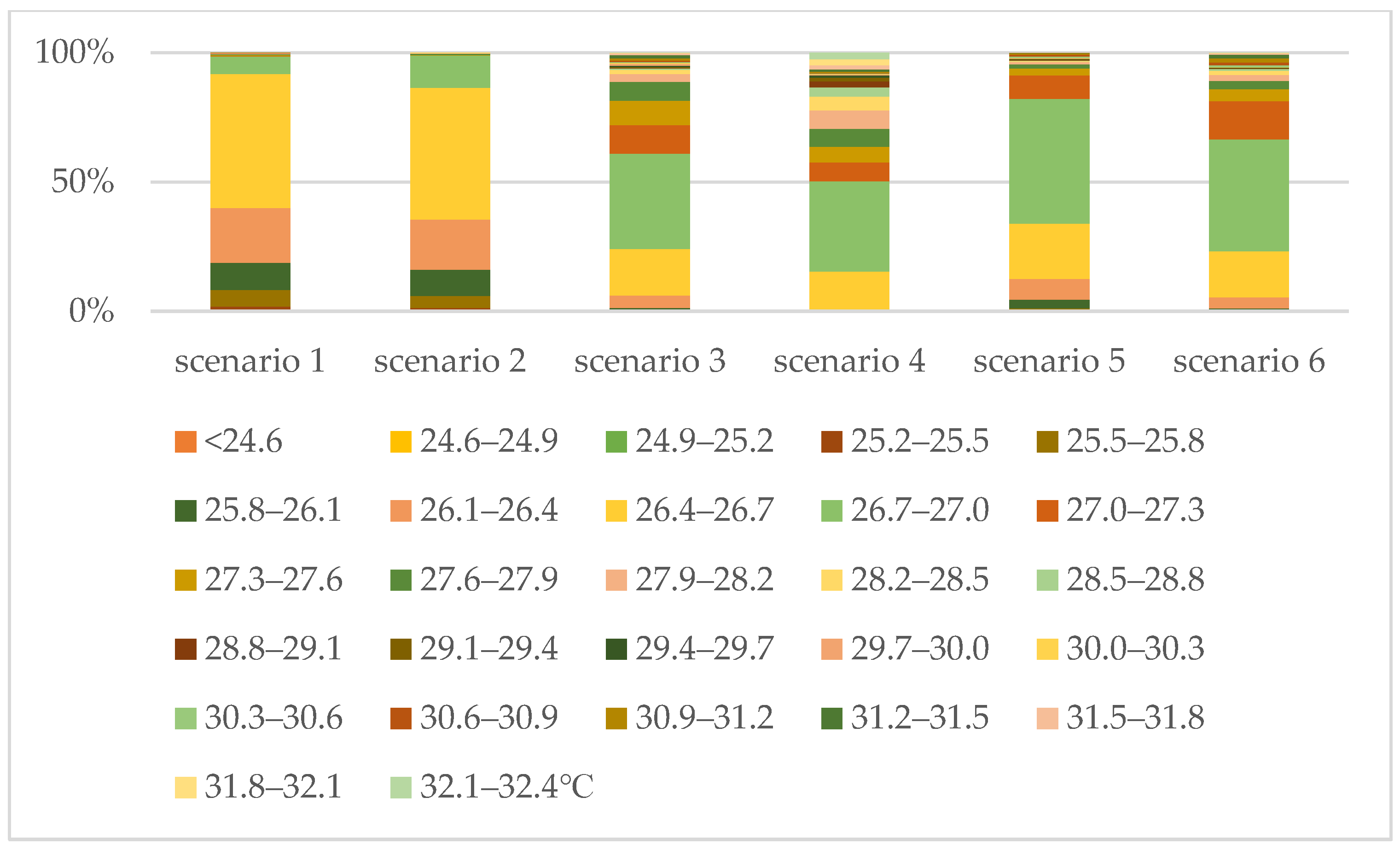


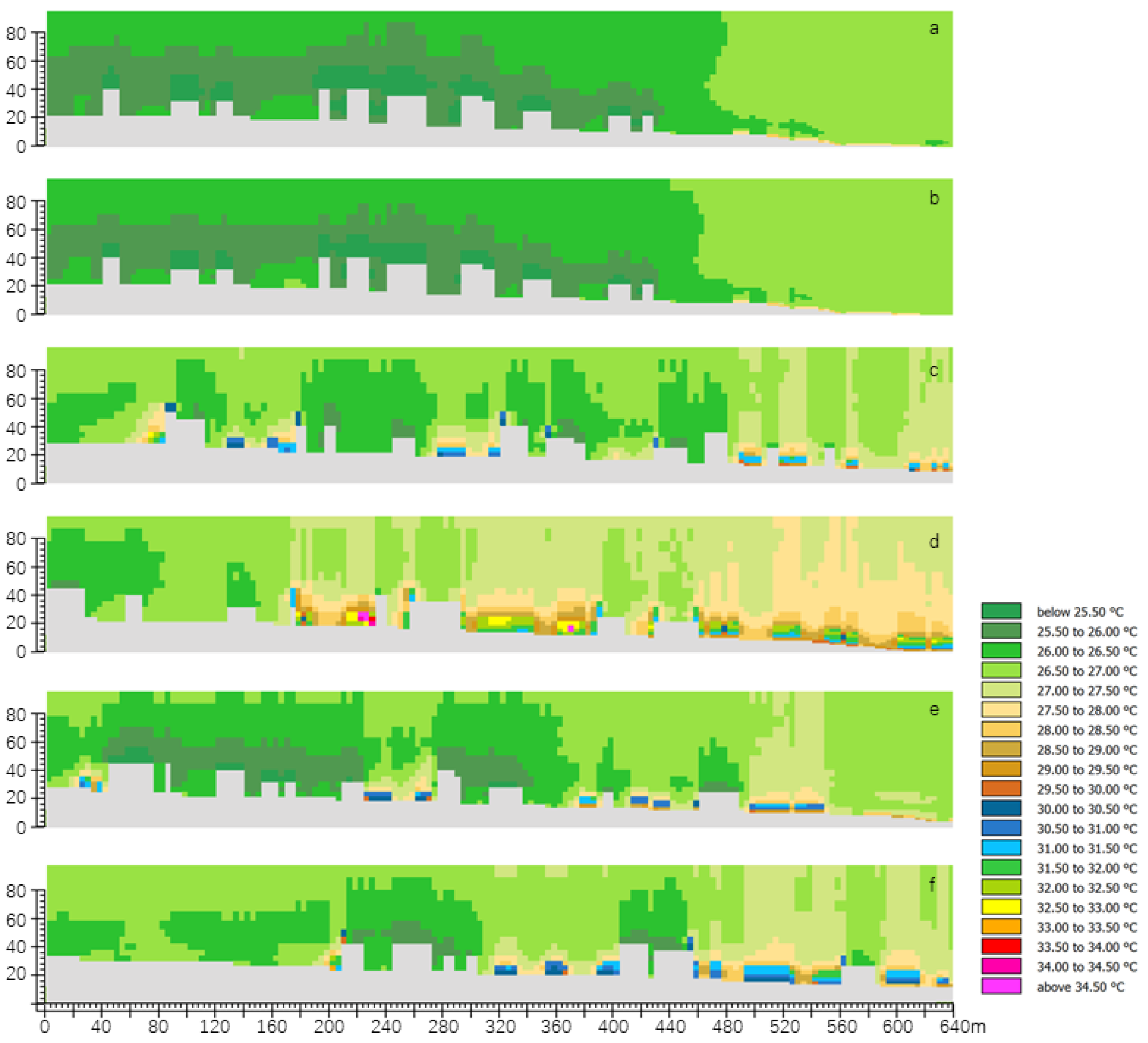

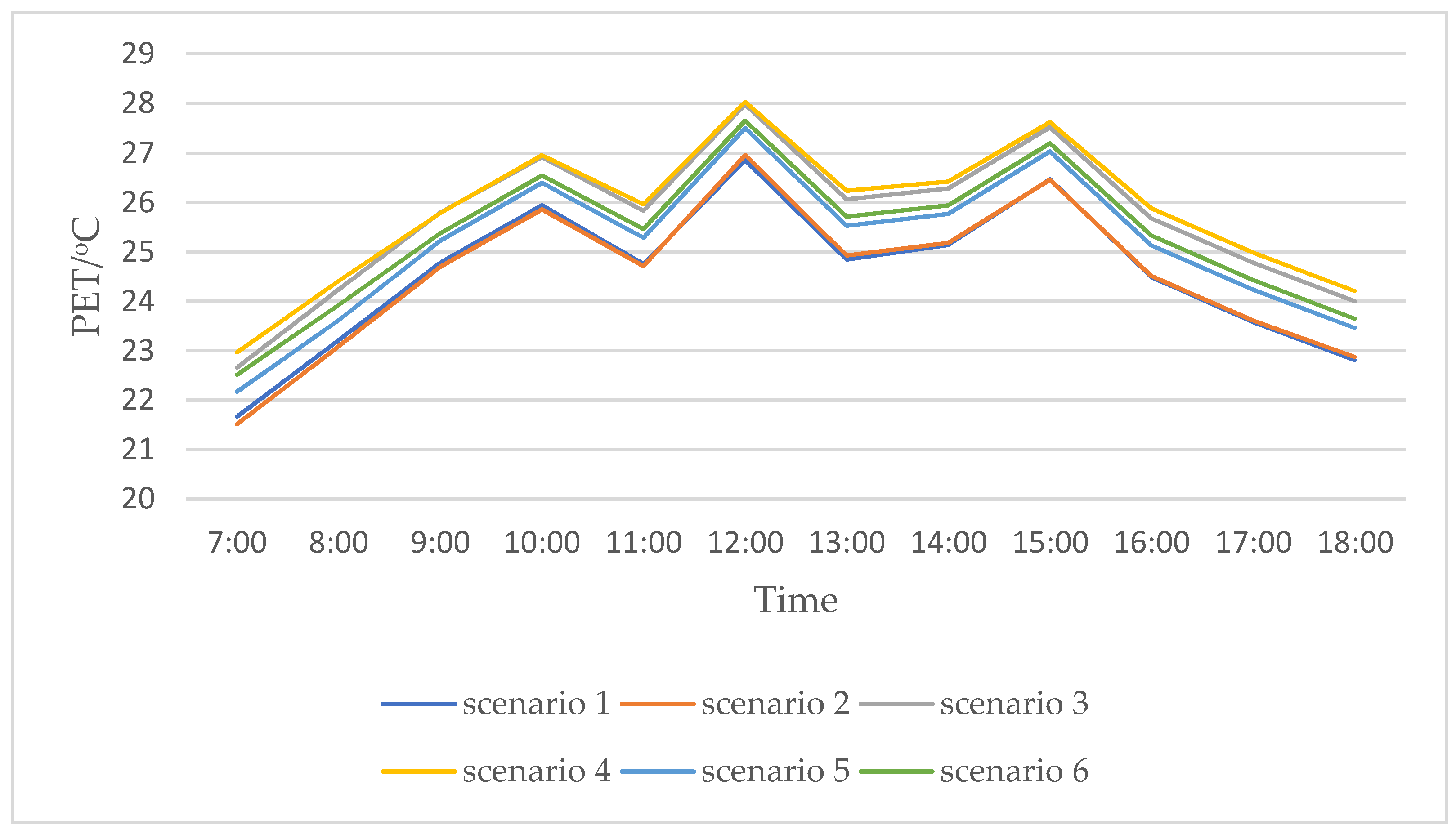
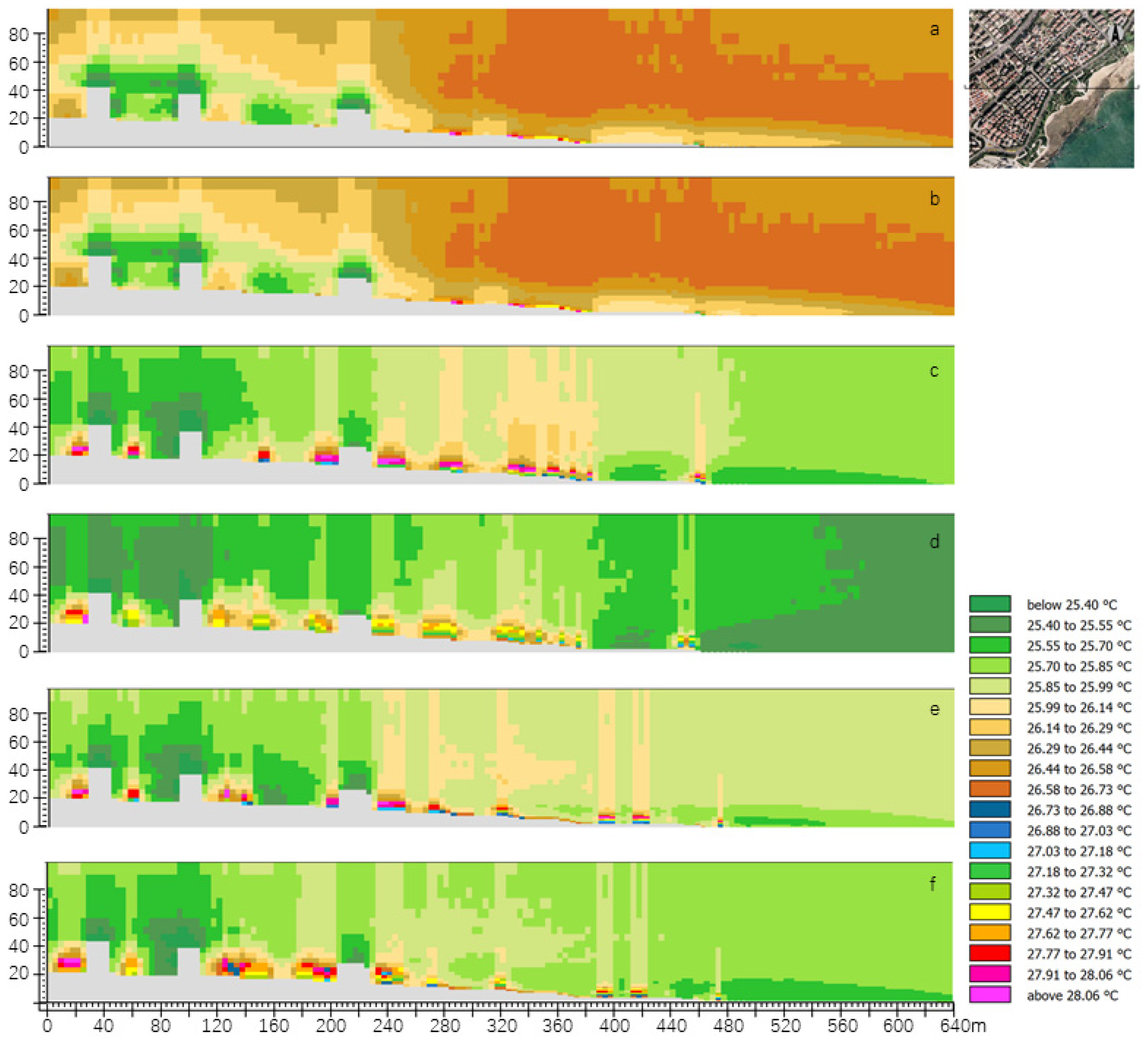
| Modular | Parameter | Values |
|---|---|---|
| Modeling | Geographical position | 36.06 N, 120.38 E |
| Cells | 165*165*25 | |
| Mesh resolution | dx = 4 m, dy = 4 m, dz = 2 m | |
| Nesting | 5 | |
| Nested grid properties | Loamy | |
| Simulation Date | 4 August | |
| Simulation duration | 48 h | |
| Meteorological | Wind speed | 1.5 m/s |
| Wind direction | 135° | |
| Air temperature | Min: 26 °C, Max: 31 °C | |
| Humidity | Min: 84%, Max: 99% | |
| Underlying surface | Asphalt | Roughness: 0.01; Reflectivity: 0.1; Emissivity: 0.9 |
| Granite Pavement | Roughness: 0.01; Reflectivity: 0.2; Emissivity: 0.9 | |
| Loamy soil | Default | |
| Modular | Parameter | Values |
| Modeling | Geographical position | 36.06 N, 120.38 E |
| Cells | 165*165*25 | |
| Mesh resolution | dx = 4 m, dy = 4 m, dz = 2 m |
| Black Pine | Ash | Grass | |
|---|---|---|---|
| Height(m) | 6 | 10 | 0.25 |
| Root depth (m) | 2 | Default | Default |
| Leaf reflectivity | 0.3 | 0.2 | 0.2 |
| LAD1 (m2/m3) | 0.15 | 0 | 0.3 |
| LAD2 (m2/m3) | 0.15 | 0 | 0.3 |
| LAD3 (m2/m3) | 0.15 | 2.18 | 0.3 |
| LAD4 (m2/m3) | 0.15 | 2.18 | 0.3 |
| LAD5 (m2/m3) | 0.65 | 2.18 | 0.3 |
| LAD6 (m2/m3) | 1 | 2.18 | 0.3 |
| LAD7 (m2/m3) | 1 | 2.18 | 0.3 |
| LAD8 (m2/m3) | 1 | 2.18 | 0.3 |
| LAD9 (m2/m3) | 0.8 | 1.72 | 0.3 |
| LAD10 (m2/m3) | 0.6 | 0 | 0.3 |
| Temperature | Humidity | |||||||
|---|---|---|---|---|---|---|---|---|
| Point 1 | Point 2 | Point 3 | Point 4 | Point 1 | Point 2 | Point 3 | Point 4 | |
| R2 | 0.99 | 0.99 | 0.65 | 0.76 | 0.97 | 0.70 | 0.62 | 0.61 |
| d | 0.95 | 0.98 | 0.89 | 0.90 | 0.76 | 0.51 | 0.84 | 0.42 |
| RMSEs | 0.58 | 0.39 | 0.30 | 1.12 | 2.62 | 5.17 | 1.30 | 5.20 |
| RMSEu | 0.06 | 0.06 | 0.72 | 0.73 | 0.35 | 1.15 | 1.14 | 10.07 |
| RMSE | 0.59 | 0.40 | 0.78 | 1.33 | 2.64 | 5.29 | 1.73 | 11.34 |
| Maximum Temperature (°C) | Minimum Temperature (°C) | Average Temperature (°C) | |
|---|---|---|---|
| Scenario 1 | 30.4 | 31.3 | 31.0 |
| Scenario 2 | 30.4 | 31.3 | 31.0 |
| Scenario 3 | 30.4 | 31.7 | 31.1 |
| Scenario 4 | 30.4 | 31.8 | 31.2 |
| Scenario 5 | 30.4 | 31.4 | 31.0 |
| Scenario 6 | 30.4 | 31.4 | 31.0 |
| Maximum PET (°C) | Minimum PET (°C) | Average PET (°C) | |
|---|---|---|---|
| Scenario 1 | 26.2 | 26.6 | 26.4 |
| Scenario 2 | 26.3 | 26.8 | 26.4 |
| Scenario 3 | 26.5 | 32.3 | 27.2 |
| Scenario 4 | 26.5 | 34.3 | 27.8 |
| Scenario 5 | 26.4 | 31.7 | 26.9 |
| Scenario 6 | 26.4 | 33.1 | 27.2 |
Disclaimer/Publisher’s Note: The statements, opinions and data contained in all publications are solely those of the individual author(s) and contributor(s) and not of MDPI and/or the editor(s). MDPI and/or the editor(s) disclaim responsibility for any injury to people or property resulting from any ideas, methods, instructions or products referred to in the content. |
© 2022 by the authors. Licensee MDPI, Basel, Switzerland. This article is an open access article distributed under the terms and conditions of the Creative Commons Attribution (CC BY) license (https://creativecommons.org/licenses/by/4.0/).
Share and Cite
Zhang, Y.; Hu, X.; Liu, Z.; Zhou, C.; Liang, H. A Greening Strategy of Mitigation of the Thermal Environment for Coastal Sloping Urban Space. Sustainability 2023, 15, 295. https://doi.org/10.3390/su15010295
Zhang Y, Hu X, Liu Z, Zhou C, Liang H. A Greening Strategy of Mitigation of the Thermal Environment for Coastal Sloping Urban Space. Sustainability. 2023; 15(1):295. https://doi.org/10.3390/su15010295
Chicago/Turabian StyleZhang, Ying, Xijun Hu, Zheng Liu, Chunling Zhou, and Hong Liang. 2023. "A Greening Strategy of Mitigation of the Thermal Environment for Coastal Sloping Urban Space" Sustainability 15, no. 1: 295. https://doi.org/10.3390/su15010295
APA StyleZhang, Y., Hu, X., Liu, Z., Zhou, C., & Liang, H. (2023). A Greening Strategy of Mitigation of the Thermal Environment for Coastal Sloping Urban Space. Sustainability, 15(1), 295. https://doi.org/10.3390/su15010295







